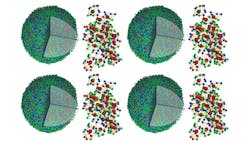Researchers Untangle the Structure of Amorphous Solids
Material engineers and scientists have long wanted to understand the atomic structures of amorphous solids such as glass, rubber and plastics more fully. Unlike the structures of crystalline materials, which scientists have been able to map in three dimensions since 1910, amorphous solids aren’t assembled in rigid, repetitive atomic units and determining their structure is a complex problem.
Now, team of researchers from Lawrence Berkeley National Laboratory and UCLA have developed a method of exploring the structure of amorphous solids on an atomic level. The method is based on atomic electron tomography, a type of 3D imaging. It involves beaming electrons through a sample and collecting the image beams as an image as it emerges on the other side. The sample is rotated so that measurements can be taken from a host of angles, creating data that can be stitched into an accurate 3D image.
To test their method, the researchers used it on a sample of metallic glass, which tends to be both stronger and more shapable than standard crystalline metals; it’s used in products ranging from electrical transformers to high-end golf clubs. Understanding the atomic structure of metallic glasses could help engineers design better versions of these materials for an even wider array of applications.
The sample measured about 8 nm in diameter and consisted of eight different metals. The researchers took 55 atomic electron tomography images of the sample to construct a 3D map of its approximately 18,000 atoms.
Researchers suspected the atoms in the sample would be arranged chaotically, based on the difficulty in determining the structure of amorphous solids. And about 85% of the atoms were in fact disorganized and disordered. Still, there were pockets in which some atoms had ordered themselves into superclusters. This showed that atoms in amorphous solids are not arranged completely randomly.
The team plans on using the new technique to image the atoms of other amorphous materials and look for or atomic defects in metals for quantum computers.

